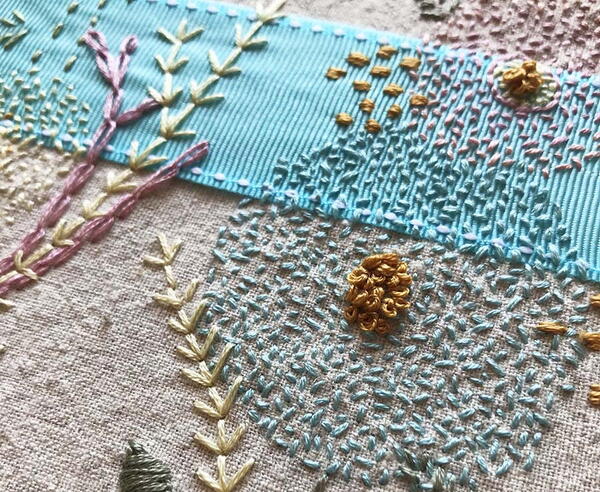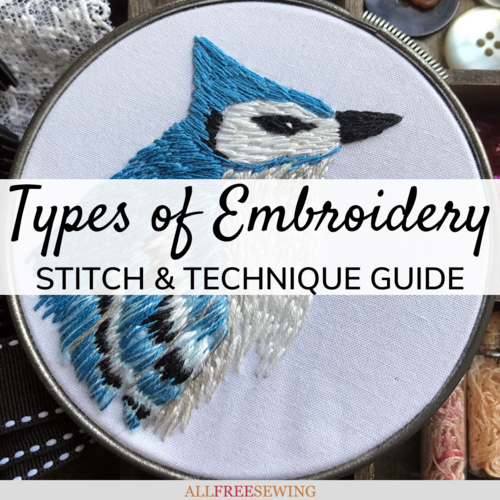Types of Embroidery: Stitches and Techniques
Learn about seven of the most popular types of embroidery styles with this guide!
Embroidery is the ancient art of embellishing and decorating fabric with a needle and thread. Some of the first signs of embroidery date back to 30,000 B.C.E., found on Cro-Magnon clothing.
Over the centuries, the methods for creating beautiful clothing, décor, and home goods have developed into many types of embroidery.
Different areas of the world contributed their own different types of stitchery, attaching different meanings to the types of stitches and the philosophy of the craft.
Embroidery is a relatively inexpensive craft and most types only require a needle, thread, and fabric. Some embroidery styles also require an embroidery hoop to stabilize the fabric.
Different types of embroidery require different needles and thread that are specific to the technique. Let’s explore a few of the embroidery stitches with images.
Wondering what you need to start embroidering? Check out 7 Essential Tools Needed for Embroidery!
Looking for more?
Sign up for one (or more) of our awesome free newsletters!
7 Popular Types of Embroidery
First: What is Embroidery?
Embroidery is the ancient art of embellishing and decorating fabric with a needle and thread. Some of the first signs of embroidery date back to 30,000 B.C.E., found on Cro-Magnon clothing.
Over the centuries, the methods for creating beautiful clothing, décor, and home goods have developed into many varieties. Different areas of the world contributed their own styles, attaching different meanings to the types of stitches and the philosophy of the craft.
Embroidery only requires a needle, thread, and fabric (plus, patience of course). Some embroidery stitches also require a hoop to keep the work stable while sewing. Different embroidery requires a specific needle and thread needed for the technique.
Let’s explore a few forms of embroidery.

Hand Embroidery
Hand embroidery is probably the type of embroidery you are most familiar with. Hand embroidery can be accomplished by learning a few, basic, embroidery stitches including: the running stitch, chain stitch, straight stitch, cross-stitch, satin stitch, stem stitch, and blanket stitch.
Mastering only a few of these stitches will enable you to begin your embroidery adventure however, there are hundreds of stitches to choose from.
In addition to different stitches, there are many different patterns, including geometric, floral, landscapes, and so much more.
Needle Painting Embroidery
Needle painting is an artistic type of hand embroidery. In this technique, the embroiderer uses long and short stitches, varying the shades of the color, so that the stitches almost appear to be paint strokes.
This method is likened to painting a picture, only instead of paints, embroidery floss is used. Popular floss manufacturers offer many shades of floss colors, with slight color changes, to enable needle painters to give their work realism, detail, depth, and shading.
Cross-Stitch Embroidery
In cross-stitch embroidery, sets of two stitches, sewn across one another at right angles (like an X) are stitched onto cloth to form an image. Think of the cross stitches as though they are pixels on a computer screen, only using floss instead of pixels. As the grid is filled in, the stitched image is created. In counted cross stitch, you “count” the squares within the base fabric’s weave.
Alternately, there are kits that have the colored design printed directly on the fabric and you simply fill in the space with tiny cross stitches in the assigned floss color.
Base fabrics for cross stitch are evenly woven and cross stitch needles (also called tapestry needles) have larger eyes and are blunter than regular sewing needles. You use the same type of threads and floss as you do in regular hand embroidery.
Image below: DIY Cross Stitch Travel Map
Chicken Scratch Embroidery
Chicken Scratch embroidery is a type of cross-stitch embroidery, used specifically on gingham checked fabric. In this type of embroidery, you use the checks in the gingham as guides for the stitches, resulting in the look of lace.
Chicken Scratch became popular during The Great Depression in the 1930s because gingham fabric was relatively inexpensive and it created the look of lace on clothing and home goods without the cost.
Crewel Embroidery
Crewel embroidery is the same as hand embroidery except you use wool threads or yarn instead of embroidery floss. The wool yarn is called, “crewel”, hence the name of this type of embroidery. Crewel has a long history, with one of its first known pieces dating back 900 years.
This historical embroidery piece, the Bayeux Tapestry, was stitched in medieval France and depicts the Norman conquest of England and is displayed in France to this day.
Crewel uses the same stitches as hand embroidery, but the thicker wool yarn produces a more textured piece of artwork. Because the wool yarn is thicker than regular embroidery floss, it is best to use crewel needles and woven fabrics, like linen.
Image below: The Secrets of Hooking Crewel Designs courtesy of Rug Hooking Magazine
Stumpwork Embroidery
In Stumpwork embroidery, the stitches are raised from the base fabric using fabric padding, wire, beads, and three-dimensional embroidery stitches. Stumpwork is another type of embroidery with a long history and was popular during the late 17th century.
Traditionally Stumpwork embroidery pieces depicted royalty, nature, and biblical and mythological themes. Fabrics with Stumpwork designs were sometimes used to cover boxes, called ‘caskets’, that were used to house sewing supplies, jewelry, and other small trinkets.
In the early 1900s, Stumpwork was used to embellish dresses and other clothing.
Today, modern embroiderers are exploring Stumpwork in new ways, using different objects to create spectacular 3D effects in their artwork.
Sashiko Embroidery
Sashiko embroidery is a type of Japanese embroidery originally used to patch and mend fabrics and clothing. The word, “sashiko” is translated to mean “little stabs”, which describes the tiny, straight stitches in Sashiko work. The small stitches are created using the running stitch and are stitched to create intricate, geometric patterns on cloth.
In mending, small patches of fabric are placed over holes in the original piece of fabric or clothing and then running stitches are used to hold the patch in place. Often the running stitches will fill the entire patch, creating a beautiful pattern and calling attention to the mended area of cloth.
In addition to vertical and horizontal running stitches, Sashiko pattern designs are also used. They are often intertwined, geometric shapes, meant to represent nature. The designs may also have special meanings such as “good fortune” or prosperity and are sewn with white floss on indigo blue fabric.
Sashiko embroidery requires the use of Sashiko needles and thread, however, darning needles and cotton floss can be substituted for the specialty supplies.
Conclusion & Resources
We hope this has inspired you to explore embroidery. With so many types to choose from, there is something for everyone. For a few more helpful resources, check out:
- How to Use an Embroidery Hoop
- Hand Sewing Needles & Types
- How to Start a Hand Stitch
- How to Sew a Straight Line by Hand
- How to Sew a French Knot
- Lazy Daisy Stitch Tutorial
- How To Back An Embroidery Hoop
Common Embroidery Stitches PDF
While this downloadable doesn't include all the embroidery stitches you might want to learn, it's a great start. There are 14 common embroidery stitches with pictures and names in this PDF. Click the button below to download the full high-res version.
About the Author
Laura Bray is an embroidery artist, educator, and writer. She lives in the Pacific Northwest with her Data Scientist husband, their teenage daughter, and a neurotic guinea pig named Oreo. She believes tea should be hot, floss should be smooth, and embroidery needles sharp. You can read about her creative adventures in embroidery and life on her website at laurabraydesigns.com.
Want More?
35+ Free Embroidery Patterns and Tutorials >>
Have you tried any of these different types of embroidery?
Let us know in the comment below.

